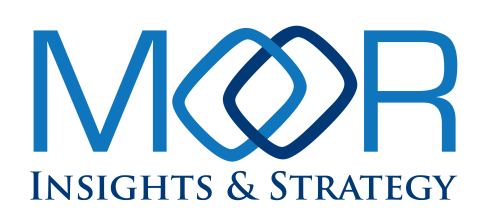
The Moor Insights & Strategy team hopes you had a great weekend!
Last week, Patrick, Melody, Matt, and Robert were in Las Vegas for Oracle CloudWorld and Netsuite SuiteWorld. Will Townsend was in London for Connected Britain, where he also moderated a panel on tech innovations in mobile networks. Jason Andersen was in Austin for JFrog swampUP 24. Robert Kramer joined Infor’s weekly “What’s Up Water Cooler” podcast to discuss the latest innovations in modern ERP systems. Check it out on YouTube.
This week, Anshel is attending the Snap Partner Summit in Santa Monica; Patrick will be at Salesforce Dreamforce in San Francisco, and Jason, Melody, and Robert will attend virtually.
Will is hosting a webinar with Zayo, “What’s Next for Your Network’s Foundation?” on September 17 (tomorrow!) It’s free to register to hear Will’s insights on the future of networks.
Our MI&S team published 19 deliverables:
- 5 Forbes Articles
- 3 MI&S Research Notes
- 7 MI&S Blog Posts
- 4 Podcasts
Over the last week, our analysts have been quoted multiple times in top-tier international publications with our thoughts on Apple, Automotive GPU IP, Border Gategway Protocol (BGP), Canva, Cyber Resilience, Google, Oracle, ZeroPoint, and Zoho Analytics.
MI&S Quick Insights
Adobe has previewed its Firefly Video Model, which is an AI-powered tool that can streamline workflows and add a lot to an editor’s creativity. The existing Firefly models are image-based. The Firefly Video Model has many useful features such as filling timeline gaps with generated B-roll footage using text prompts, camera controls, and reference images to fill in the missing sections. It can create variations of existing concepts or brainstorm on demand to generate new elements and provide new ideas. Firefly can also create atmospheric effects, 2-D and 3-D animations, and other visual enhancements. Firefly can remove unwanted objects, smooth transitions, and more, allowing editors to focus on creative storytelling and collaboration. Everything considered, AI provides Adobe editors a powerful video toolkit with many creative advantages. It’s a big step forward for video editing.
I’ve been speculating on OpenAI’s stealth project code-named Strawberry, which is believed to have superior reasoning power. Well, OpenAI may have just released Strawberry in the form of its latest model, o1, which appears to be a groundbreaking language model that demonstrates improved reasoning. o1 excels in several complex tasks ranging from math to code challenges. It even beats human experts with certain problem-solving skills. It also has an impressive ability to explain its thought process and how it arrives at its conclusions, as well as the ability to learn and improve over time.
That said, o1 also has some challenges. For example, training with large datasets may be a problem. However, the model is still under development, so we can wait to see if that improves. Despite any training problems, its reasoning ability already appears to be a plus that will set new model standards. I’m looking forward to seeing this model in its fully developed form.
Adobe has previewed its Firefly Video Model, which is an AI-powered tool that can streamline workflows and add a lot to an editor’s creativity. The existing Firefly models are image-based. The Firefly Video Model has many useful features such as filling timeline gaps with generated B-roll footage using text prompts, camera controls, and reference images to fill in the missing sections. It can create variations of existing concepts or brainstorm on demand to generate new elements and provide new ideas. Firefly can also create atmospheric effects, 2-D and 3-D animations, and other visual enhancements. Firefly can remove unwanted objects, smooth transitions, and more, allowing editors to focus on creative storytelling and collaboration. Everything considered, AI provides Adobe editors a powerful video toolkit with many creative advantages. It’s a big step forward for video editing.
I’ve been speculating on OpenAI’s stealth project code-named Strawberry, which is believed to have superior reasoning power. Well, OpenAI may have just released Strawberry in the form of its latest model, o1, which appears to be a groundbreaking language model that demonstrates improved reasoning. o1 excels in several complex tasks ranging from math to code challenges. It even beats human experts with certain problem-solving skills. It also has an impressive ability to explain its thought process and how it arrives at its conclusions, as well as the ability to learn and improve over time.
That said, o1 also has some challenges. For example, training with large datasets may be a problem. However, the model is still under development, so we can wait to see if that improves. Despite any training problems, its reasoning ability already appears to be a plus that will set new model standards. I’m looking forward to seeing this model in its fully developed form.
JFrog held its annual SwampUp event, where it made a number of interesting announcements. Long known for its Artifactory code-storage solution, JFrog has been steadily adding new capabilities and acquiring technology. The focus on security has been an especially high priority, and this week JFrog announced a runtime protection service enabling end-to-end artifact security for both source and binary code. This was coupled with the formal announcement of its MLOps solution, which is based on its acquisition of Qwak this summer. My research on how JFrog has elevated itself from a DevOps point tool to a full-blown platform will be available soon.
In addition to its own innovations, JFrog also announced a partnership with GitHub that shows some long-term potential. One of the first big steps was the integration of Artifactory with GitHub Copilot. While there have been many announcements of this type over the past few months, this one stands out. Given that Artifactory provides a rigorous and secure registry for all development artifacts, this integration makes it easy for developers to have an AI assistant specifically configured around their companies’ standards. For instance, a developer will get assistance based only upon specifically curated artifacts, versions, and standards established by existing rules and policies. This out-of-the-box integration is something that other tools either cannot do yet or that would require a lengthy integration process.
Over the next few months, we will see a new arms race, with a range of vendors showing off their AI agents. This started last week at Oracle CloudWorld and NetSuite SuiteWorld. It makes sense for application platforms to begin introducing agents—and dev tools to build agents. Agents will be the next big thing now that LLMs and bots (which are actually the simplest agents) are becoming common. This will be a major focus of my research over the rest of 2024. Over time, agents will become as ubiquitous as apps on your phone, all built to manage multi-step activities by using AI. You can think of them as dev assistants that can help you write code. An agent will be able to write the code, develop a test plan, execute the tests, give feedback, and recommend where to deploy. All you will need to do is approve the tasks, and the code will be deployed.
Last week Amazon announced that the SageMaker platform will include added support for Amazon Enterprise Kubernetes Service with its HyperPod-managed MLops solution. This allows IT and DevOps teams to use the familiar Kubernetes interface and more easily manage HyperPod clusters. This solution also ties in with AWS Cloudwatch to enable production monitoring of the clusters. This is a great step in enabling IT Ops and DevOps to “de-silo” AI and machine learning workloads.
Salesforce’s new Agentforce platform aims to change how businesses operate by introducing autonomous AI agents that work alongside employees to handle tasks in various departments such as service, sales, marketing, and commerce. These AI agents can analyze data, make decisions, and take independent action, freeing human workers to focus on more strategic and complex tasks. This could lead to increased efficiency and the ability to scale operations on demand. Early adopters such as Wiley have reported significant increases in case resolution using Agentforce, highlighting the potential of this new technology to increase customer satisfaction as well.
While Agentforce promises efficiency and scalability, its implementation could lead to job displacement and over-reliance on AI, potentially impacting employee and customer relationships. Concerns around data privacy, bias, and unexpected errors also need addressing. Additionally, the cost and complexity of implementing such technology may pose challenges, especially for smaller businesses.
However, Salesforce is emphasizing the importance of its Data Cloud in powering the accuracy and capabilities of its new AI solutions. By unifying apps, data, and AI agents on a single platform, Salesforce aims to reinforce its position as a leader dedicated to customer-centric solutions in the evolving CRM landscape.
Oracle announced a strategic partnership with AWS through which Oracle Cloud Infrastructure (OCI) will reside in AWS datacenters, with Exadata infrastructure housing Oracle Autonomous Database and other services. This service, Oracle Database@AWS, is aimed at enabling customers to deploy their Oracle database environments natively in AWS for easier, more performant integration of enterprise data with services such as Bedrock, SageMaker, and other analytics tools. No ETL. No complicated data pipeline management.
How will this work? Customers will go through their AWS console to select and deploy Oracle Database@AWS, using either AWS or Oracle credits to activate. Database@AWS will spin up as a service for use. L1 service will be provided by AWS; anything beyond that will be a collaborative effort between the two companies.
AWS marks the last of the big cloud providers to embrace this native multicloud model that Oracle pioneered. And while this partnership may seem surprising on its surface, it actually makes perfect sense. Virtually every Oracle customer uses AWS, and virtually every large AWS customer uses Oracle. Many of these customers want to integrate their rich enterprise data with the AI and analytics tools that are available in the cloud—and AWS is that cloud of choice. Rather than make life complicated, or force customers into a choice that would be suboptimal regardless of which cloud they chose, OCI and AWS have found a way to address these needs.
I mark this as a big win for both companies. Oracle has effectively mainstreamed this concept of native multicloud – or cloud within a cloud. And AWS has sent a big signal to the market about its customer-first approach.
Lenovo has made a slew of announcements aimed at enterprise IT organizations struggling with enabling and supporting the AI environment. GPU-as-a-service (GPUaaS), AIOps, and deeper insights into liquid cooling are three launches that should drive efficiencies across the financial, operations, and sustainability vectors. Here are the three offerings in a nutshell:
- With GPUaaS, the company has delivered a new solution in its TruScale lineup that allows organizations to deploy and meter uses of NVIDIA GPUs across AI and HPC workloads. This includes built-in consumption metering that can be used to charge back to internal customers.
- XClarity One gets a significant upgrade as the company leans more heavily into AIOps, delivering greater levels of automation to IT operations.
- Lenovo’s Neptune liquid cooling becomes easier to deploy and utilize with Lenovo advisory services designed to help customers better understand how to most efficiently use liquid cooling. This is especially important as AI becomes more present in the enterprise datacenter.
I like how Lenovo is driving differentiation across the areas where enterprise IT and datacenter operators struggle.
How does this GPUaaS work? It’s designed to make life easier for organizations with multiple business units. This is like when I was working in government IT in Florida, where we had 39 different agencies—and a number of entities within each agency—that were funded separately. GPUaaS would enable me to apportion GPU resources across the state—dedicated GPU resources along with dedicated bill-back. This is not simply differentiated; it’s differentiated and it delivers value to organizations that are trying to better utilize or leverage the very large investments they are making in performant computing platforms.
What’s in it for Lenovo? I see two things. First, this is a differentiated service that can deliver real value into the enterprise—a market segment where Lenovo has been trying to establish itself for some time. If Lenovo can gain traction with a service such as GPUaaS, it can perhaps find opportunities downstream, in the more general-purpose compute clusters and farms.
Second, I think this is maybe an opportunity for Lenovo to establish itself with a higher-margin AI add-on business in consulting services. Something we’ve seen across the quarterly earnings of the OEMs is that the AI infrastructure market has contributed big top-line gains, but not a lot of margin. Consulting add-ons could help Lenovo change that.
Canva is raising the price of its Teams subscription by up to 300%, citing the addition of AI-powered features as justification. This move has been met with mixed reactions from users, with some questioning the value proposition while others find the new features to be worth the increased cost. Canva seems to have overlooked a more flexible AI pricing strategy, forcing customers to pay for bundled features instead of choosing the AI tools they actually need.
Canva’s decision to bundle AI features into a significantly higher-priced plan risks alienating its core user base of smaller teams and individuals that may not require the full suite of AI capabilities. By potentially forcing customers to pay for features they don’t need, Canva could drive them to seek more affordable and customizable alternatives. In a rapidly evolving AI landscape where costs are decreasing, offering AI features as add-ons or adopting a usage-based pricing model could be a more sustainable and customer-centric strategy.
Zoho Analytics has unveiled over 100 new enhancements, including an upgraded AI assistant and a machine learning studio. The focus is on democratizing data analysis to empower users across all roles to extract actionable insights. This comprehensive upgrade positions Zoho Analytics as a powerful and user-friendly BI solution at a competitive price. You can read my full analysis in this Forbes contribution.
Zoho has released version 6.0 of its AI-powered Analytics platform, bringing new AI and machine learning features. The update offers more options for teams to collaborate, analyze data, predict trends, automate tasks, and connect data for better decision-making. AI-driven automation simplifies metrics, reporting, and dashboards, while AutoML allows users to create custom models. The platform is also more flexible and extensible, integrating smoothly with tools like Power BI and Tableau.
Oracle CloudWorld is one of the best tech events of the year, especially when you pair it with the company’s NetSuite SuiteWorld conference. Let’s recap these back-to-back events from last week.
Oracle came out strong with a slew of announcements, emphasizing how AI is now deeply embedded across its offerings—from Oracle Cloud Infrastructure (OCI) to Oracle Fusion Cloud Applications. Hot topics included partnerships with IBM, Amazon Web Services, Google, and Microsoft Azure to provide customers with more-unified experiences.
Larry Ellison remains as sharp and visionary as ever. (I hope I look that great when I’m 80.) He focused on passwords and Zero-trust Packet Routing (ZPR) to simplify the complexities of network security.
I had the opportunity to meet with the Oracle Cloud ERP and Oracle Cloud SCM teams (#mywheelhouse) to discuss some of their impressive updates. For example, an RFID-powered solution now ensures Oracle Cloud SCM healthcare customers get the right supplies to the right places at the right times—driving better patient care experiences.
ERP remains the backbone of enterprise operations, and by capitalizing on its modern data management and AI-driven solutions, Oracle can push its customers to fully leverage these innovations. I’ll dive deeper into this topic in an upcoming article, including how the new Oracle Intelligent Data Lake, powered by OCI, helps ERP customers integrate and analyze structured and unstructured data in an all-in-one solution.
NetSuite announced some notable AI-powered enhancements: a new procurement solution, a Salesforce connector, improved project management, upgrades to the user experience, fresh training resources, and an integrated benefits offering. To be fair, some of these features should have already been standard. I’ve covered this in more detail in my latest piece on NetSuite.
As always, real-world customer stories breathe life into Oracle’s narrative. Organizations including Clayton Homes, the CIA, BNP Paribas, MGM Resorts International, Cloudflare, DHL, Uber, WideLabs, and Guardian Life took the stage to explain how Oracle’s solutions are transforming industries.
In other news, IBM and Oracle announced that IBM Consulting will support Oracle customers in gaining more value from generative AI and its growing challenges. “Our clients are eager to extend generative AI initiatives but they’re also concerned about rising compute costs, lack of in-house AI skills, AI assistant sprawl, and management oversight,” said Corinne Koppel, Global Oracle Practice Leader, IBM Consulting.
Broadcom is another company to suffer from the AI bubble-burst phenomenon. Despite its strong earnings, the company’s stock took a dip based on investor concerns about future earnings. The fears may be unwarranted, since Broadcom is well diversified beyond GenAI and its silicon is used pervasively across many enterprise networking infrastructure providers.
SAP has completed its acquisition of WalkMe, a platform that enhances user experiences with features such as in-app walkthroughs and step-by-step guides. It simplifies complex software tasks, increases productivity, shortens training time, and improves software usability by offering real-time assistance and automation of routine processes. WalkMe supports employee onboarding and can be integrated with enterprise systems such as CRM, ERP, and HR. The acquisition is set to complement SAP’s Joule AI, RISE with SAP, and GROW with SAP programs by further enhancing user engagement and simplifying digital adoption.
Curious about how NetSuite transformed from an early SaaS innovator to a major player in the ERP landscape, especially following its acquisition by Oracle? Dive into my latest Research Note as I explore NetSuite’s remarkable journey, its differentiators, and the strategic advantages that have positioned NetSuite as a go-to ERP solution for small to medium-sized businesses across multiple industries.
IBM has announced its plan to acquire Accelalpha, a global Oracle services provider specializing in implementing, integrating, and managing Oracle Cloud applications. Accelalpha serves clients around the world, focusing on industries such as distribution, heavy industry, and financial services. The acquisition will enhance IBM’s consulting expertise, particularly in ERP, SCM, logistics, finance, EPM, and customer transformation services. The deal is expected to close in Q4 2024, pending regulatory approval. Financial terms remain undisclosed.
Acquisitions remain a key strategy for many companies in the ERP space, particularly to enhance resources and consulting expertise. A recent example is Capgemini’s announcement of its acquisition of Syniti to expand its data management capabilities and strengthen its expertise in SAP projects.
Mastercard is set to acquire Recorded Future, a cybersecurity company, for $2.65 billion to strengthen its fight against fraud and cyber threats. The acquisition, expected to close in early 2025, builds on an existing partnership between the two companies. Mastercard cites the growing threat of cybercrime, which is projected to cost trillions globally this year, as a driving force behind this strategic move.
PayPal is partnering with Shopify to handle a portion of Shopify Payments in the U.S. PayPal will become an additional processor for credit and debit card transactions. This will create a consolidated view for merchants by integrating PayPal wallet transactions with Shopify Payments. The deal expands a global strategic partnership between the two companies. It shows how PayPal is increasingly being selected as a preferred platform by major commerce brands, technology companies, and payment processors.
At Oracle CloudWorld in Las Vegas, Oracle announced a new open skills architecture within Oracle Dynamic Skills that helps organizations develop, curate, and execute an enterprise-wide skills-based talent strategy. Oracle Dynamic Skills is part of Oracle Fusion Cloud HCM. This new architecture should help HR leaders leverage AI to better understand and leverage the skills of their employees, identify skills gaps, expand access to talent and nurture it, and make smarter workforce decisions.
Oracle Dynamic Skills aims to simplify the process of managing skills data, regardless of an organization’s current capability in this area. The platform helps customers align employee skills with business goals to optimize the workforce and stay ahead in a rapidly changing job market. Using this product’s AI-powered capabilities, HR leaders can create a comprehensive skills inventory, enrich the data with external sources, analyze skills gaps and trends, leverage third-party skills data and labor market analytics, and effectively manage a skills library.
Skills have emerged as a critical metric for assessing an organization’s potential. Adopting a skills-based talent strategy can offer valuable workforce insights, facilitate access to a broader range of talent, and ultimately boost overall company performance. Oracle’s offering comes at a good time because talent needs are rapidly changing—yet many organizations struggle to initiate their skills journey.
The new iPhone 16 was announced last week, and pre-orders began on Friday. The biggest takeaway from the launch is that the iPhone 16 lineup is Apple’s most complete in ages, with the base model iPhone and the Pro series having very comparable chips and likely the same AI performance. The trade-in offers also seem very aggressive, which I believe is because Apple wants as many users to have Apple Intelligence-capable devices as possible to entice more developers to develop for it. The biggest problem that Apple Intelligence has—other than its low install base—is that many of its features aren’t available at launch. Apple is broadly saying “Fall” as the window for some of its features, but the biggest ones, for example the new version of Siri, won’t be available until 2025. My advice for anyone looking to buy a new iPhone is that this is probably the best version of the base-level iPhone in many years, including near-parity with the Pro on most features. Still, it might not be a significant upgrade for anyone who already has an iPhone 15 Pro, especially since those customers will also be getting Apple Intelligence.
During the event launching the new iPhone, Apple announced a series of new wearables, including a thinner, larger-screen Apple Watch and a bunch of updated and new AirPods. While the update to the AirPods Max brought nothing more than new colors and USB-C connectivity, Apple did announce new versions of its base-model AirPods—the AirPods 4—in two versions, as well as major updates to the AirPods Pro 2. The biggest updates to the latter, in my opinion, are the hearing test and the ability to use the AirPods Pro 2 as hearing aids. Apple just got FDA clearance for this last week, right after the event. At $249, these might be the cheapest hearing aids on the market. While I don’t believe they will work well for someone with severe hearing loss who always needs hearing aids, I do believe they might work well for people who have impaired hearing and might need temporary assistance, especially when talking to friends and family over the phone. At $249, these might also bring hearing aids within reach for people who could never afford them otherwise—as long as they have an iPhone, which might be the most limiting factor.
Google has started shipping the new Pixel Watch 3, including the new 45mm size. (It previously offered only 41mm.) I have been using it for a few days now, and the battery life is fantastic. Thanks to the included Fitbit software, it is truly the only other watch with comparable fitness and health capabilities to Apple. I genuinely appreciate the design and integration with the Pixel 9 Pro Fold. I am also reviewing the accessories and really appreciate the improvements to them, although I do wish the metal mesh wristband were compatible with the 45mm model. More broadly, I wish Google had better third-party support for its watches, but the reality is that the majority of the market belongs to the Apple Watch, while on the Android side most of the market is dominated by the Samsung Galaxy Watch.
Ericsson has formed a joint venture with 12 of the world’s leading network operators to create a company that manages and sells 5G network APIs. This joint venture will be 50% owned by Ericsson and 50% owned by the operators, which should create cohesion that simply has not existed before in the market. This announcement includes all three big carriers in the U.S. and will likely drive 5G Standalone applications and the monetization of 5G unlike anything that has been possible before. The really important thing here is that this new venture will be able to sell services to ISVs and other customers across multiple carriers at global scale. This move is truly unprecedented in scale and cohesiveness.
T-Mobile sent a test alert via satellite using its new partnership with SpaceX, covering more than 500,000 square miles. This approach should ensure that people receive emergency alerts even in the most secluded areas where cell service might not reach. For example, this could be especially important for people in National Parks and other remote areas during fire season who would otherwise not know that a wildfire is headed their way until it’s too late. This capability won’t be limited to T-Mobile users, either; it could potentially be used nationwide by all operators, and even enabled by the federal government for emergency preparedness and response. This could truly be a feature that saves lives.
AST SpaceMobile announced the successful launch of its first five satellites aboard a SpaceX rocket, which finally sets the company on a course to initiate service with its partners AT&T and Verizon. AST SpaceMobile’s BlueBird satellites are much larger than traditional low-earth orbit satellites, but they can serve larger areas and more users simultaneously and with higher speeds. The company’s approach will also serve a long list of other carriers around the world, but AT&T and Verizon will be among the most prominent in the U.S. I believe that AST SpaceMobile will compete with existing satellite operators, including SpaceX’s Starlink.
United Airlines announced that in 2025 its entire fleet of planes will offer free high-speed Wi-Fi connectivity thanks to a new partnership with SpaceX’s Starlink. While United has not given details on the speeds that users can expect from this new upgrade, they can range anywhere from 40 Mbps to 220 Mbps for the entire plane. For passengers, United’s announcement is significant because it means upgrades to Wi-Fi coverage and speeds for more than 1,000 planes. That said, this is a significant undertaking that will likely put new stresses on SpaceX’s Starlink satellite network. It will be interesting to see how SpaceX responds to this new stress and how users’ Wi-Fi speeds are affected.
Quantinuum has released a new roadmap that projects it will create a universal, fault-tolerant quantum computer by 2030. The roadmap forecasts that Quantinuum will achieve this major milestone using a fifth-generation quantum computer, Apollo, that will be able execute millions of gates. If all goes as planned, Apollo will be able to achieve quantum advantage using many high-fidelity logical qubits by scaling its QCCD architecture.
Quantinuum has collaborated with Microsoft on several recent breakthroughs. It demonstrated 12 logical qubits on its System Model H2 quantum computer, plus a chemistry simulation using a combination of logical qubits, AI, and HPC. Microsoft’s Azure Quantum Elements has also integrated Quantinuum’s InQuanto software into the product offering. The Quantinuum roadmap anticipates that the company will continue building increasing numbers of reliable logical qubits and leveraging partnerships with industry leaders like Microsoft.
The U.S. federal government recently published guidance related to border gateway protocol (BGP) internet routing security. BGP is instrumental in determining the optimal routes for information to be transmitted over the internet across public and private networks. There is a concern here, which is that BGP predates the launch of the public internet—and cyberthreats have vastly increased in sophistication. A more modern protocol, Open Shortest Path First (OSPF), could address BGP’s shortcomings and provide a more secure routing methodology.
IBM and ESPN are continuing their collaboration for the eighth year with the ESPN Fantasy app for fantasy football. As with IBM’s work on the US Open, Wimbledon, and The Masters, the watsonx data and AI platform is supporting over 12 million fantasy football users with advanced AI-driven tools.
“Millions of people participate in fantasy football on the ESPN Fantasy platform each year, and they are constantly looking for the best information available to compete in and win their leagues,” said Noah Syken, VP of sports and entertainment partnerships for IBM. “This year’s enhancements in the ESPN Fantasy platform put watsonx-powered insights directly in their hands, giving them access to personalized, data-driven insights that help deliver on these expectations.”
New tools such as “Top Contributing Factors” in Waiver and Trade Grades offer personalized player grades and AI-generated insights based on complex data, along with detailed measures of player performance and expert articles.
Qualcomm’s front-of-the-jersey Snapdragon sponsorship with Manchester United goes far beyond a logo on a shirt. It brings technology into the mix, enhancing fan experiences with better connectivity, data-driven insights, and more interactive features at the stadium. As Qualcomm CMO Don McGuire put it, “Our Manchester United partnership is how we come together with one of the most revered sports franchises in the world and how we build to scale for the Snapdragon brand—from awareness all the way through to affinity and advocacy.”
Read my Research Note to discover how Qualcomm and Manchester United are elevating sponsorship to new heights, and be sure to catch regular insights from Melody Brue, Anshel Sag, and me on the Game Time Tech podcast (linked below) as we explore how technology is shaping the future of sports.
Amid many announcements at Oracle CloudWorld, the new Oracle Fusion Cloud Sustainability application probably hasn’t gotten the attention it deserves. This new tool aims to streamline sustainability data management and reporting, enabling organizations to make more informed decisions and accelerate progress on their environmental targets.
Oracle Fusion Cloud Sustainability integrates data from various Oracle Cloud applications to allow automated tracking of sustainability-related activities, contextualized data analysis within existing business processes, and simplified reporting through pre-built dashboards. The solution also provides rigorous audit trails, emission factor mapping, and third-party integrations, giving businesses a broad toolkit to measure and improve their environmental performance. Notably, Oracle offers this new capability to existing customers at no additional cost, which suggests its commitment to supporting sustainability efforts.
Ericsson is attempting to accelerate mobile network programmability with the recent announcement of a joint venture with several mobile network operators. It is a logical move given that the company has written off its entire acquisition of Vonage and needs to chart a new course. From my perspective, Ericsson was ahead of the telecommunications industry with its API strategy, but with Nokia entering the category with its Network as Code platform just one year ago and the GSMA now providing guidelines, mobile network programmability may finally find its rhythm.
Forbes Articles Published
- Pixel 9 Launch: Google’s Approach to AI Becomes Clearer – Anshel Sag
- Splitting Intel’s Fabs from Its Design Business Now Doesn’t Make Sense – Patrick Moorhead
- Antitrust Probes into Nvidia: What are the Implications? – Patrick Moorhead
- Oracle Cloud Infrastructure and AWS Form Strategic Partnership – Matt Kimball
- Adobe Launches AI-Driven B2B Marketing Solution – Melody Brue
Research Notes Published
- How NetSuite Has Shaped the SaaS and Cloud ERP Landscape – Robert Kramer, Patrick Moorhead
- Looking at AI Benchmarking from MLCommons – Matt Kimball, Patrick Moorhead
- Qualcomm Expands the Snapdragon Brand through Strategic Sports Partnerships – Robert Kramer
Blog Posts Published
- VMware Explore Brings Broadcom’s Private Cloud Strategy Into Focus – Matt Kimball, Patrick Moorhead
- Meta Shares Hard Numbers for Llama’s Enterprise AI Value – Patrick Moorhead
- When Automation and AI are Better than People for Software Deployment – Jason Andersen
- Box Acquires Alphamoon to Boost Intelligent Document Processing – Melody Brue, Patrick Moorhead
- Ready or Not, IT Automation is Going Through Some Big Changes – Jason Andersen
- Copilot+ PC Roundup: Stellar Performance, Great Battery Life – Anshel Sag, Patrick Moorhead
- Ambarella and Plus Aim to Give Better Perception to Autonomous Driving – Anshel Sag, Patrick Moorhead
Podcasts Published
Six Five (Patrick Moorhead)
- The Six Five, Episode 232: Talking Apple, Oracle & AWS, Oracle Earnings, Google & Apple, OpenAI, Adobe
- Six Five On the Road: Insights on Digital Sovereignty with AWS
- The Six Five On the Road: Modern Endpoint Manageability: From Virtual Remediation to AI PCs
- The Six Five, Episode 231: Talking NVIDIA, Intel, Qualcomm, Broadcom, HPE
Don’t miss future MI&S Podcast episodes! Subscribe to our YouTube Channel here.
Citations
Apple / Airpods Pro 2 / Anshel Sag / The Verge
Apple’s AirPods Pro 2 could forever change how people access hearing aids
Apple / Apple Watch News / Anshel Sag / Tech News World
Apple Weaves AI Into Latest Watch, AirPods, iPhone Models
Automotive GPU IP / Anshel Sag / Business Wire
Imagination Announces Highest Performance Automotive GPU IP with FuSa Advancement
Automotive GPU IP / Anshel Sag / New Electronics
Imagination announces automotive GPU IP with FuSa advancement
Border Gateway Protocol (BGP) / Will Townsend / Network Computing
White House Road Map Provides Guidance on BGP Internet Routing Security
Canva / Saas & AI / Melody Brue / Venture Journeys
A Simple Framework for Evaluating SaaS Resilience to AI
Cyber Resilience / Matt Kimball / StateTech
Backup and Recovery Systems Augment Government Cyber Resilience
Google / Smart Glasses / Anshel Sag / HT Haztech
Smart Glasses 2.0: How AI is Driving the Next Generation of Wearable Tech
Oracle / Earnings & AWS Partnership / Patrick Moorhead / Yahoo! Finance
Oracle will be ‘data broker’ for the gen. AI future: Analyst
ZeroPoint / AI Memory / Matt Kimball / Blocks & Files
ZeroPoint aims to tackle AI memory bottlenecks with compression IP
ZeroPoint / Matt Kimball & Patrick Moorhead / PR Newswire
ZeroPoint Technologies Releases New Hardware-Accelerated Memory Optimization Solutions and Receives Industry Recognition for Innovation
Zoho / Zoho Analytics / Melody Brue / Business Wire
Zoho Launches AI-Rich, Highly Extensible Version of Zoho Analytics, Democratizing Self-Service BI to Any Persona or Business
New Gear or Software We Are Using and Testing
- Cisco Desk Pro (Melody Brue)
- OnePlus Buds Pro 3 (Anshel Sag)
- Insta360 Link2 4K AI Webcam (Anshel Sag)
- Pixel Watch 3 (Anshel Sag)
- Pixel 9 Pro Fold (Anshel Sag)
Events MI&S Plans on Attending In-Person or Virtually (New)
Unless otherwise noted, our analysts will be attending the following events in person.
- Snap Partner Summit, September 17, Santa Monica (Anshel Sag)
- Zayo Network Transformation webinar moderation, September 17 (Will Townsend)
- Salesforce Dreamforce, September 17-19, San Francisco (Patrick Moorhead) (virtual – Jason Andersen, Melody Brue, Robert Kramer)
- Intel Innovation, September 23-26 — EVENT CANCELED
- HP Imagine, September 24, Palo Alto (Anshel Sag)
- Meta Connect, September 25, San Jose (Anshel Sag)
- Verint Engage, September 23-25, Orlando (Melody Brue)
- Infor Annual Summit, September 30-October 2, Las Vegas (Robert Kramer)
- Snap Partner Summit, September 17, Santa Monica (Anshel Sag)
- Zayo Network Transformation webinar moderation, September 17 (Will Townsend)
- Salesforce Dreamforce, September 17-19, San Francisco (Patrick Moorhead) (virtual – Jason Andersen, Melody Brue, Robert Kramer)
- Intel Innovation, September 23-26 — EVENT CANCELED
- HP Imagine, September 24, Palo Alto (Anshel Sag)
- Meta Connect, September 25, San Jose (Anshel Sag)
- Verint Engage, September 23-25, Orlando (Melody Brue)
- Infor Annual Summit, September 30-October 2, Las Vegas (Robert Kramer)
- Fem.AI Summit, Menlo Park, October 1 (Melody Brue)
- Microsoft Industry Analyst Event, Burlington, Mass, October 2 (Melody Brue)
- LogicMonitor, Austin, October 2-4 (Robert Kramer)
- Teradata, October 7-10, Los Angeles (Robert Kramer)
- Zoomtopia, San Jose, October 8-9 (Melody Brue)
- Embedded World NA, Austin, October 8-10 (Bill Curtis)
- MWC Americas and T-Mobile for Business Unconventional Awards event judge, October 8-10, Las Vegas (Will Townsend)
- AWS GenAI Summit, October 9-10, Seattle (Jason Andersen, Robert Kramer)
- AdobeMAX, October 14-16, Miami (Melody Brue)
- Lenovo Global Analyst Summit & Tech World, October 14-17, Bellevue, WA (Matt Kimball, Paul Smith-Goodson, Anshel Sag)
- IBM Analyst Summit, October 16-18, New York City (Matt Kimball, Robert Kramer)
- Snapdragon Summit, Maui, October 20-24 (Will Townsend)
- WebexOne, October 21-24, Miami (Melody Brue)
- RISC-V Summit, October 22-23 — virtual (Matt Kimball)
- Cisco Partner Summit, Los Angeles, October 28–30, 2024 (Robert Kramer)
- SAP SuccessConnect, October 28-30 – virtual (Melody Brue)
- Red Hat Analyst Day, October 29 (Jason Andersen — virtual)
- GitHub Universe, October 29-30, San Francisco (Jason Andersen)
- 5G Techritory, October 30-31, Riga (Will Townsend)
- Dell Tech Analyst Summit, November 6-8, Austin (Matt Kimball, Anshel Sag, Paul Smith-Goodson)
- Apptio TBM Conference, November 4-5, San Diego (Jason Andersen)
- IBM, November 6-8, New York City (Paul Smith-Goodson)
- Fyuz, November 11-13, Dublin (Will Townsend)
- Veeam Analyst Summit, November 11-13, Scottsdale, AZ (Robert Kramer)
- Box Analyst Summit, November 12-13, San Francisco (Melody Brue)
- Microsoft Ignite, November 18-22, Chicago (Robert Kramer – virtual, Will Townsend – virtual)
- Super Computing, November 18-22, Atlanta (Matt Kimball)
- NTT R&D Forum, November 19-23, Tokyo (Will Townsend)
- AWS re:Invent, December 2-6, Las Vegas (Robert Kramer, Will Townsend, Jason Andersen, Paul Smith-Goodson)
- T-Mobile Analyst Summit, December 9-10 (Anshel Sag)
- Marvel Industry Analyst Day, December 10, Santa Clara (Matt Kimball)
- ServiceNow Global Industry Analyst Digital Summit, December 10 (Jason Andersen, Melody Brue, Robert Kramer – virtual)
Subscribe
Want to talk to the team? Get in touch here!






























































































